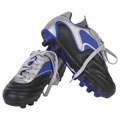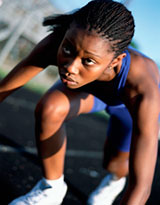- Body
- Fitness
- Nutrition
- Illness &
disability-

- Types of illnesses and disabilities
- Dealing with medical issues
- Coping with your feelings
- Taking care of your body
- Dealing with school
- Relationships
- Becoming independent
- For friends and family
- Stories, celebrities, chats, and other fun stuff
-
Quiz: How much do you know about taking good care of yourself?
-
-
Links to more information
-
-
- Drugs, alcohol
& smoking - Your
feelings - Relationships
- Bullying
- Safety
- Your
future - Environmental
health
Skip section navigation (navigation may have changed)
Section navigation

http://www.girlshealth.gov/
Fitness
Keeping safe and injury-free

There are many things you need to do to stay safe and injury-free during exercise. Review these items so that you don’t get hurt!
- Warming up and cooling down
- Important exercise safety tips
- Using the right equipment
- Female athlete triad
- Over-exercising
- Knee injuries
- Osteoporosis
Warming up and cooling down
Before you start exercising, you need to warm up your muscles. It is best to warm up your muscles before stretching them. You can warm up by walking at an easy pace before stretching. Then stretch by starting at the top of your body and working your way down. Slowly stretch your calf, quad, groin, and hamstring muscles (view sample stretches.) Warming up can also include jogging slowly, doing knee lifts, and arm circles.
Make sure to cool down and stretch after exercising, too! A cool-down is a gentle exercise or stretch that helps the body return to its normal state after vigorous exercise. Cool-downs help your pulse (or heart rate) return to normal and can help prevent your muscles from feeling stiff after a workout.
Important exercise safety tips
- See your doctor for a sports physical before you start a sport.
- Don’t exercise when it is really hot and humid out. You do not want your body to overheat or get dehydrated. If it’s very hot or humid outside, try moving your exercise indoors that day. Also, if you live in an area with high air pollution, exercise early in the day or at night and avoid congested streets and rush hour traffic.
- Drink water before, during, and after exercise or sports competitions. Read more about the water your body needs.
- Make sure you warm up and stretch your muscles for 5 minutes before and after workouts to make your muscles more flexible. It is easer to get hurt if your muscles are not stretched. It is also important to increase the intensity of your workout gradually. If you exercise intensely right away, you could risk getting hurt. Check out tips on how to stretch before exercising.
- See a doctor or let your parents/guardian know if: 1) You are in severe pain, 2) you see swelling around where you got hurt, or 3) The pain gets in the way of sleep and activities. Don’t jump back to your regular exercise after getting hurt because you could get hurt again. Follow your doctor’s orders for how to care for your injury and when you can be active again. This includes following instructions for use of pain medicine.
- Follow the rules of the game! The rules are there, in part, to keep you safe.
Using the right equipment
When you exercise or play sports, it is important to use the right safety equipment.
 | Helmets are needed for sports such as baseball, softball, biking, snow skiing, and rollerblading. Make sure you wear the right helmet for the sport you are playing and that it fits well. Also make sure that the helmet you wear for biking has a sticker from the Consumer Product Safety Commission (CPSC), which means that it is safe for this activity. |
 | Mouth guards protect your mouth, teeth, and tongue. You should wear a guard if there’s a chance you could get hit in the head while taking part in activities such as volleyball, basketball, or martial arts. You can find mouth guards at sport stores or your dentist. It will also help keep your mouth safe to take out your retainer. |
 | Special eye protection is needed for sports such as ice hockey, soccer, and basketball. Goggles and face masks should fit snugly and have cushion for a comfortable fit. If you wear glasses, you need to get fitted for guards that fit over your glasses. You could also buy special prescription goggles, which cost about $60 or more. These guards and goggles are made with a special plastic called polycarbonate (say: pahl-ee-kar-buh-nayt). This special plastic will not hurt your eyes. |
 | It is important to wear the right footwear for your sport. Check with your coach or an athletic shoe salesperson about what shoes to wear. |
 | Wrist, knee, and elbow pads can help prevent broken bones when you are inline skating/rollerblading, skate or snow boarding, or playing sports such as hockey. |
Female athlete triad
 Some girls who play sports or exercise intensely are at risk for a problem called female athlete triad. Female athlete triad is a combination of three conditions: disordered eating, amenorrhea (or missed periods), and osteoporosis. A female athlete can have one, two, or all three parts of the triad.
Some girls who play sports or exercise intensely are at risk for a problem called female athlete triad. Female athlete triad is a combination of three conditions: disordered eating, amenorrhea (or missed periods), and osteoporosis. A female athlete can have one, two, or all three parts of the triad.
Eating disorders. Most female athletes who develop an eating disorder are trying to lose weight so they can be better at their sport. This kind of eating disorder can range from avoiding certain types of food the athlete thinks are "bad" (such as foods containing fat) to serious eating disorders like anorexia nervosa or bulimia nervosa.
Menstrual dysfunction.A missed period is a concern for girls and women who over-exercise. Your body needs a certain amount of fat to function and to have regular periods. Eating right and exercising is important for having a healthy body, but some girls take it too far. Too much exercising or very strict dieting can use up your body fat and delay your period, or cause it to stop until you gain some weight back. Not having menstrual periods is called amenorrhea — a sign that hormone patterns have changed. Oligomenorrhea (say: ah-li-go-men-ah-REE-uh) is having very few periods, usually with cycles that last longer than 35 days. Women who suffer from anorexia and elite women athletes who train seriously for competition often have amenorrhea or oligomenorrhea.
Low bone mineral density. Osteopenia (say: oss-tee-oh-PEEN-ee-uh) and osteoporosis (say: oss-tee-oh-per-OH-sis) is when your bones become weak. If a female athlete doesn’t eat a balanced diet that includes plenty of calcium, she can develop osteopenia or osteoperosis. This can ruin a female athlete's career because it may lead to stress fractures and other injuries. Usually, the teen years are a time when girls should be building up their bone mass to their highest levels — called peak bone mass. Not getting enough calcium during the teen years can also have a lasting effect on how strong a girl's bones are later in life. Visit the Best Bones Forever! Web site to learn more about strong and healthy bones!
Learn more about female athlete triad, including signs and symptoms!
Over-exercising can actually be harmful
 Sometimes you really can have too much of a good thing. If you over-exercise your emotional health can suffer. It is linked to:
Sometimes you really can have too much of a good thing. If you over-exercise your emotional health can suffer. It is linked to:
Sometimes, teens over-exercise along with having an eating disorder such as anorexia. People with anorexia take extreme steps to lose weight, including not eating at all. This combination puts your health in danger.
If you think that you may be over-exercising or have an eating disorder, talk about it with someone you can trust. Talk to a school counselor or nurse. The longer you wait, the harder it will be to bring it up. If you think that your friend may have one of these problems, help them find someone to talk to. Be supportive and let them know you care about them.
Knee injuries
It’s fairly common for teens to develop knee injuries, especially if you’re very active in sports. If your knee hurts so much that it affects your usual routine, you can’t put weight on it, or is red or swollen, you should see a doctor.
You can help prevent knee injuries by:
- Wearing the correct protective equipment for your sport (for example, knee pads and shin guards)
- Warming up and cooling down before exercise
- Stretching regularly
- Bending your knees when you land from a jump
- Using correct technique for your sport, like cutting and pivoting
Learn more about the kinds of knee injuries that are possible and different treatments!
Osteoporosis
Osteoporosis is when your bones become weak and break easily. If a female athlete doesn’t eat a balanced diet that includes plenty of calcium, she can develop osteoporosis. This can ruin a female athlete's career because it may lead to stress fractures and other injuries.
The teen years are the most important time for girls to build up their bone mass to their highest levels — called peak bone mass. Not getting enough calcium, vitamin D, and physical activity during the teen years can have a lasting effect on how strong a girl's bones are later in life.
Content last updated October 09, 2009





